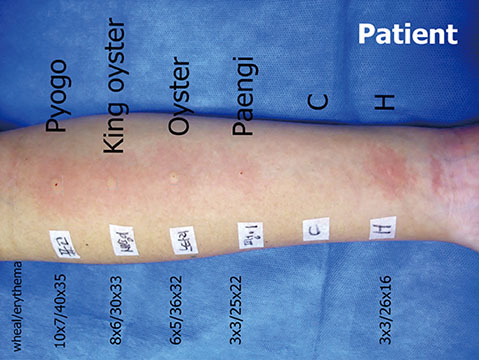Allergy Asthma Respir Dis.
2015 Jan;3(1):82-85. 10.4168/aard.2015.3.1.82.
Anaphylaxis following mushrooms ingestion
- Affiliations
-
- 1Department of Allergy & Clinical Immunology, Ajou University School of Medicine, Suwon, Korea. ye9007@ajou.ac.kr
- KMID: 2262284
- DOI: http://doi.org/10.4168/aard.2015.3.1.82
Abstract
- Various foods can induce anaphylaxis. However, mushrooms-induced anaphylaxis has not been reported in Korea. We report a patient with past anaphylactic episode caused by mushroom ingestion, confirmed by the skin test and specific IgE antibody to mushrooms. A 17-year-old girl with asthma was referred to our department due to itchy throat, dyspnea, and urticaria within 10 minutes after ingestion of a soup containing Oyster mushrooms. She presented an itching throat after ingestion of cooked mushrooms 3 years before the visit. She had an elevated serum IgE level (205 kU/L) and was sensitized to house dust mites. Skin prick tests with mushroom extracts showed a strong positive on Oyster and King Oyster mushrooms as well as Pyogo mushroom. The specific IgE antibody to each mushroom measured by enzyme-linked immunosorbent assay showed significant positive results to Oyster and Pyogo mushroom extracts, but was negative on King Oyster mushroom. We educated her to avoid eating Oyster and Pyogo mushrooms for preventing recurrence, whereas we couldn't perform oral challenge tests.
Keyword
MeSH Terms
Figure
Reference
-
1. Lim DH. Epidemiology of anaphylaxis in Korean children. Korean J Pediatr. 2008; 51:351–354.
Article2. Yang MS, Lee SH, Kim TW, Kwon JW, Lee SM, Kim SH, et al. Epidemiologic and clinical features of anaphylaxis in Korea. Ann Allergy Asthma Immunol. 2008; 100:31–36.
Article3. Jang GC, Chang YS, Choi SH, Song WJ, Lee SY, Park HS, et al. Overview of anaphylaxis in Korea: diagnosis and management. Allergy Asthma Respir Dis. 2013; 1:181–196.
Article4. Lee SY, Kim KW, Lee HH, Lim DH, Chung HL, Kim SW, et al. Incidence and clinical characteristics of pediatric emergency department visits of children with severe food allergy. Korean J Asthma Allergy Clin Immunol. 2012; 32:169–175.5. Ye YM, Kim MK, Kang HR, Kim TB, Sohn SW, Koh YI, et al. Predictors of the severity and serious outcomes of anaphylaxis in korean adults: a multicenter retrospective case study. Allergy Asthma Immunol Res. 2015; 7:22–29.
Article6. Aalto-Korte K, Susitaival P, Kaminska R, Makinen-Kiljunen S. Occupational protein contact dermatitis from shiitake mushroom and demonstration of shiitake-specific immunoglobulin E. Contact Dermatitis. 2005; 53:211–213.
Article7. Choi BW, Min KU, Kim YY, Moon HB, Chang SI, Kang SY, et al. Type III hypersensitivity reaction in mushroom growers. Korean J Intern Med. 1991; 6:27–32.
Article8. Quirce S. Eosinophilic bronchitis in the workplace. Curr Opin Allergy Clin Immunol. 2004; 4:87–91.
Article9. Senti G, Leser C, Lundberg M, Wuthrich B. Allergic asthma to shiitake and oyster mushroom. Allergy. 2000; 55:975–976.
Article10. Toda T, Yamaguchi M, Nakase Y, Sugimoto N, Suzukawa M, Nagase H, et al. A case of anaphylactic reaction following matsutake mushroom ingestion: demonstration of histamine release reaction of basophils. Allergol Int. 2010; 59:417–419.
Article11. Ichikawa K, Ito R, Kobayashi Y, Aihara M, Osuna H, Aihara Y. A pediatric case of anaphylaxis caused by matsutake mushroom (Tricholoma matsutake) ingestion. Allergol Int. 2006; 55:85–88.
Article12. Lee SK, Cho HK, Cho SH, Kim SS, Nahm DH, Park HS. Occupational asthma and rhinitis caused by multiple herbal agents in a pharmacist. Ann Allergy Asthma Immunol. 2001; 86:469–474.
Article13. Bahn JW, Lee JY, Jang SH, Kim SH, Kim HM, Park HS. Sensitization to Empynase(pronase B) in exposed hospital personnel and identification of the Empynase allergen. Clin Exp Allergy. 2006; 36:352–358.
Article14. Koivikko A, Savolainen J. Mushroom allergy. Allergy. 1988; 43:1–10.
Article15. Helbling A, Gayer F, Brander KA. Respiratory allergy to mushroom spores: not well recognized, but relevant. Ann Allergy Asthma Immunol. 1999; 83:17–19.
Article16. Kopp T, Mastan P, Mothes N, Tzaneva S, Stingl G, Tanew A. Systemic allergic contact dermatitis due to consumption of raw shiitake mushroom. Clin Exp Dermatol. 2009; 34:e910–e913.
Article17. Castillo C, Lara B, Cruz MJ, Munoz X. Protein identification of two allergens of Boletus edulis causing occupational asthma. Am J Respir Crit Care Med. 2013; 187:1146–1148.
Article18. Helbling A, Bonadies N, Brander KA, Pichler WJ. Boletus edulis: a digestion-resistant allergen may be relevant for food allergy. Clin Exp Allergy. 2002; 32:771–775.
Article19. Herrera I, Moneo I, Caballero ML, de Paz S, Perez Pimiento A, Rebollo S. Food allergy to spinach and mushroom. Allergy. 2002; 57:261–262.
Article20. Carrapatoso I, Bartolome B, Faria E, Ribeiro F, Luis AS. Food anaphylaxis to mushrooms? Clin Transl Allergy. 2013; 3:Suppl 3. P151.
Article
- Full Text Links
- Actions
-
Cited
- CITED
-
- Close
- Share
- Similar articles
-
- Five Cases of Shiitake Dermatitis
- Raw shiitake-induced systemic allergic contact dermatitis
- Wheat - Dependent Exercise-Induced Anaphylaxis Occurred With a Delayed Onset of 10 to 24 hours After Wheat Ingestion: A Case Report
- A case of parsely dependent sxercise-induced anaphylaxsis
- Clinical Features of Adult Patients with Anaphylaxis Associated with Food in Gwangju and Chonnam Area



